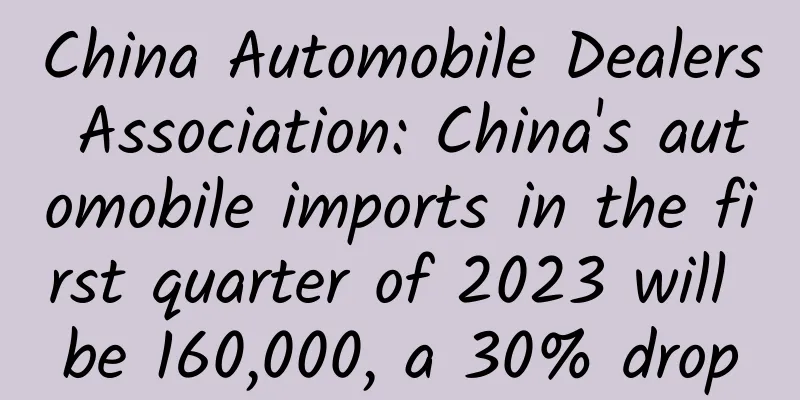China Automobile Dealers Association: China's automobile imports in the first quarter of 2023 will be 160,000, a 30% drop

|
Although the domestic luxury car market is generally good, China's imports of imported cars have continued to decline at an average annual rate of about 10% from 1.24 million units in 2017 to 880,000 units in 2022. The high-end market demand in January-March 2023 was good, but the import volume of automobiles was only 160,000 units, a year-on-year plunge of 30%, which is still lower than the low point of imports in the past decade. 56,900 units were imported in March, a year-on-year decrease of 28%, and the recent downturn in automobile imports has weakened. Among them, the sharp decline in Japanese imports in 2023 exceeded expectations. In an environment where the supply chain continues to improve, the import of ordinary hybrid passenger cars fell by 60%, far exceeding expectations. The core driving force of the import market growth is still the consumption upgrade of passenger cars. Therefore, compared with ordinary fuel vehicles, the overall trend of luxury cars and imported cars is very good, but the electrification transformation has changed the demand for fuel vehicles, and the demand for imported fuel vehicles has also declined significantly. As international relations continue to become more complicated, we still need to prepare for the rainy day and establish more import models to maintain a reasonable scale of imported cars. 1. Overall trend of China's automobile imports 1. Characteristics of the growth rate of automobile imports The scale of imports dropped sharply in 2023, with only 160,000 units imported from January to March, a year-on-year decrease of 30%. The current monthly import volume remains at an average of around 60,000 units. The imported car market stabilized in 2021, with annual imports reaching 930,000 units, a year-on-year decrease of 0%. In 2022, automobile imports reached 880,000 units, a year-on-year decrease of 5%, a significant decrease compared to imports in 2020. From January to March 2023, 163,000 vehicles were imported, down 30% year-on-year. In March, 56,900 vehicles were imported, down 28% year-on-year, and the recent downturn in automobile imports has weakened. Considering the international supply shortage caused by the previous epidemic and chip shortage, there is still great potential to standardize international standards in the future, increase the increase in imported vehicles and drive the recovery of growth throughout the year. 2. Monthly trend of vehicle imports Imported passenger cars returned to normal after the epidemic. From the monthly trend, imports in recent years still show seasonal characteristics, showing a high in summer and a roller coaster trend of peaking and falling. Imports in January-March 2023 were significantly lower than in 2022, and imports were abnormally sluggish. 3. Structural characteristics of imported complete vehicles The import car market was relatively stable from 2017 to 2019. In 2023, 163,000 vehicles were imported, a significant decline from 2022. In the past two years, the import of traditional trucks and buses has been good, especially the import of light trucks and pickups, which reflects the high market recognition of American pickups. Passenger cars account for 98% of the absolute majority of the automobile import structure this year, among which the import of four-wheel drive SUVs has been weak in the past two years. Commercial vehicle imports performed strongly in 2023, especially truck imports, which rebounded significantly, with pickup trucks being the strongest. 4. Structural characteristics of new energy vehicle imports The market for imported passenger cars powered by traditional fuel has declined significantly, while imported pure electric passenger cars have performed strongly, and diesel cars have also rebounded. The share of diesel trucks in trucks has decreased, while the share of gasoline trucks has increased significantly. The import performance of high-end gasoline pickup trucks in January-March 2023 has improved. The new energy passenger vehicle market has performed relatively strongly recently, and the imported pure electric vehicle market has also performed relatively well. Due to the import structure dominated by passenger cars, the proportion of diesel vehicles among passenger cars has continued to decline in recent years, while the proportion of diesel vehicles among trucks has dropped significantly. 5. Characteristics of the displacement structure of imported complete vehicles The displacement of imported passenger cars is concentrated in gasoline models below 2 liters, accounting for half of the total passenger car imports. However, the recent strong import trend is the large-displacement imported cars above 2 liters, and the market has a strong trend towards high-end. The performance of gasoline models above 2 liters in January-March 2023 has improved slightly. 6. Characteristics of countries importing new energy vehicles The import volume of new energy vehicles was large before 2019, but the decline in pure electric vehicles caused by Tesla's domestic production in 2021 was large. In 2021, pure electric vehicles declined significantly due to the impact of Tesla's domestic production, but the development trend of new energy in 2022 led more companies to import new energy. The recovery and growth of plug-in hybrid and pure electric vehicles in January-March 2023 reflects the trend of overseas new energy transformation. 2. Overseas Automobile Market Structure 1. Import characteristics by country Before 2019, Asian imported cars grew rapidly, European imported cars remained stable, and North American imported cars showed a downward trend. The performance of imported cars recovering after the epidemic in 2020 was differentiated, while European imported cars performed relatively strongly in 2022. In 2023, Japan's imported cars plummeted significantly, with Japanese imports falling by 64% in March, while imports from the United States and other countries fell by 17%, and European imports fell by 6%. 2. Monthly trend of vehicle imports In 2023, the main countries with relatively good performance in imported cars are Slovakia, South Korea, Mexico, etc., and the import volume of South Korea and other countries increased significantly in March. However, Japan's imports in March fell sharply year-on-year, Germany and the United States' imports were weak, and some European imported cars showed differentiated year-on-year performance. The import share of major countries remained above 98%, and markets such as Mexico have recovered significantly. 3. Automobile Market Sales Volume 1. Overall sales volume of imported vehicles At present, the sales performance of imported cars is slightly worse than that of domestic luxury cars. In 2021, the sales volume of imported cars reached 940,000 units, a decrease of 6% compared with the sales volume in 2020. In 2022, the sales volume of imported cars reached 840,000 units, a significant decrease of 10% compared with 2021, and was relatively weaker than the performance of domestic cars. From January to March 2023, the sales volume of imported cars reached 200,000 units, a year-on-year increase of 2% compared with 2022. Due to the promotion of the low base, the retail sales of imported cars this year were stable. 2. Characteristics of imported car brands At present, the growth of imported cars mainly relies on the growth of luxury cars, and the proportion of luxury cars has increased from 80% in 2019 to 90% in 2023. The import proportion of super luxury cars has increased slightly, reflecting that the purchasing power of the super high-end consumer group has actually increased. 3. Trend characteristics of imported car brands In the past few years, Lexus was still the strongest imported car brand, but it has declined sharply recently. In recent years, the market share of Mercedes-Benz and BMW has continued to grow, and in 2023 they have become the top imported car brands. Mercedes-Benz and BMW's imported car retail sales in March performed very well year-on-year, but Toyota's imports were very poor, with a sharp decline in the past two years. The performance of imported cars from Mercedes-Benz and BMW was relatively stable, with Mercedes-Benz performing relatively well in March. The sales of imported cars from Porsche continued to grow rapidly, making it a relatively strong brand among European imported cars. 4. Trend characteristics of imported car models The performance of traditional luxury cars in China in 2023 was relatively weak. Among them, the best import sales performance came from the main German brands, with the main models of Mercedes-Benz and BMW performing extremely well. |
<<: Computex 2014: If you don’t go crazy, you’ll be old
Recommend
WeChat nicknames can now be circled, try it now
Dan Di, who is dedicated to making WeChat fancy, ...
Weather satellite: predicting wind, frost, rain and snow
Among all kinds of satellites, there are some tha...
What do you think of the top 10 most talked-about marketing campaigns in 2018?
As public attention becomes distributed in a &quo...
Take a management lesson from Steve Jobs
[[121185]] "Steve Jobs", published in N...
Article ghostwriting and soft copywriting services, how much does it cost to ghostwrite an article?
Many friends who need ghostwriting for copywritin...
30 high-quality information flow cases from 18 industries, check them out all at once!
This article shares with you 30 high-quality case...
VR is being despised as it becomes cheaper and cheaper: What do we need to reflect on?
2016 was the first year of the VR industry. Inter...
Fengyun Media's "Online Qianchuan Improvement Course" improves Qianchuan's awareness and the effect of Qianchuan's advertising
Course Contents: 1. Teach you how to build a 1:10...
How to master bidding promotion?
The number of consultations has not decreased, bu...
When will electric cars be cheaper than fuel cars? Technological progress and economies of scale will be key factors in reducing costs
my country has 2 million new energy vehicles, but...
Over one million new users in half a year, activation cost less than 2 yuan, how did I achieve it through QQ space large account promotion
Friends who do promotion should all have this fee...
Yuyue Medical's triple "dilemma"
Recently, the price of a blood oximeter made by Y...
Vaccination to prevent smallpox: mankind's great victory in the fight against viruses
One day in July 2014, a scientist accidentally fo...
Popular Science Online | All diseases in the world are caused by our immune system losing the battle
Modern people believe in chemical drugs and think...









